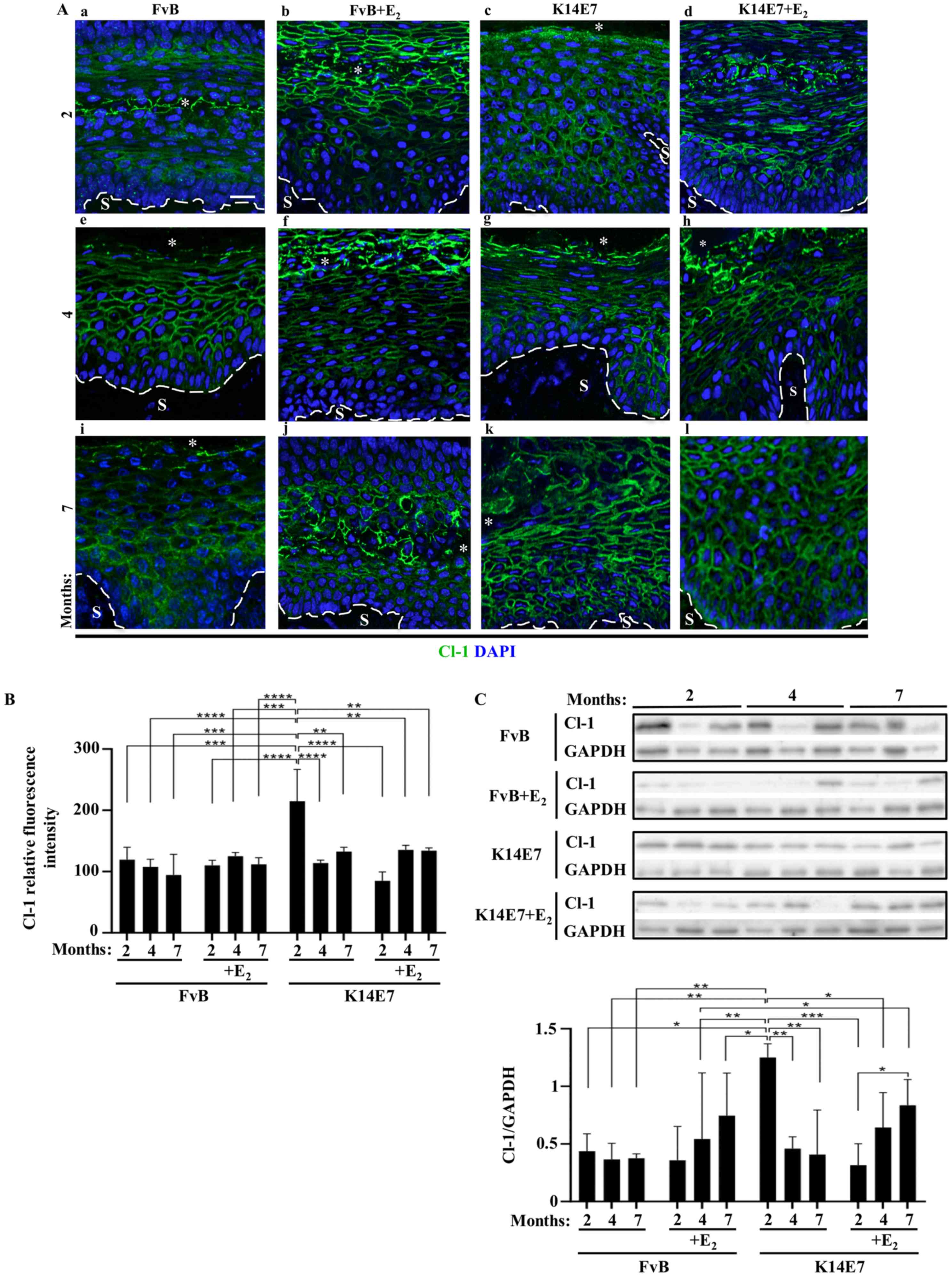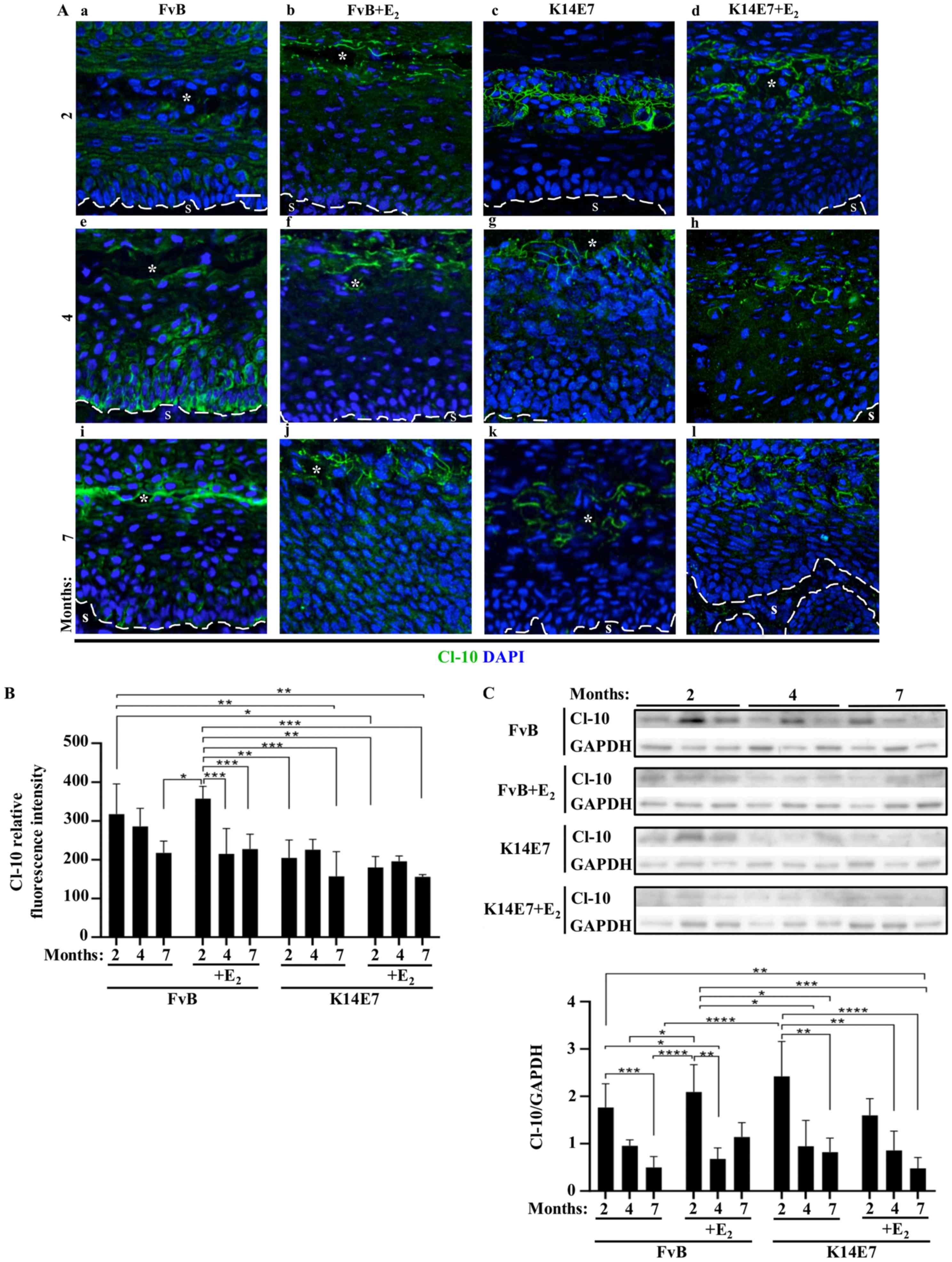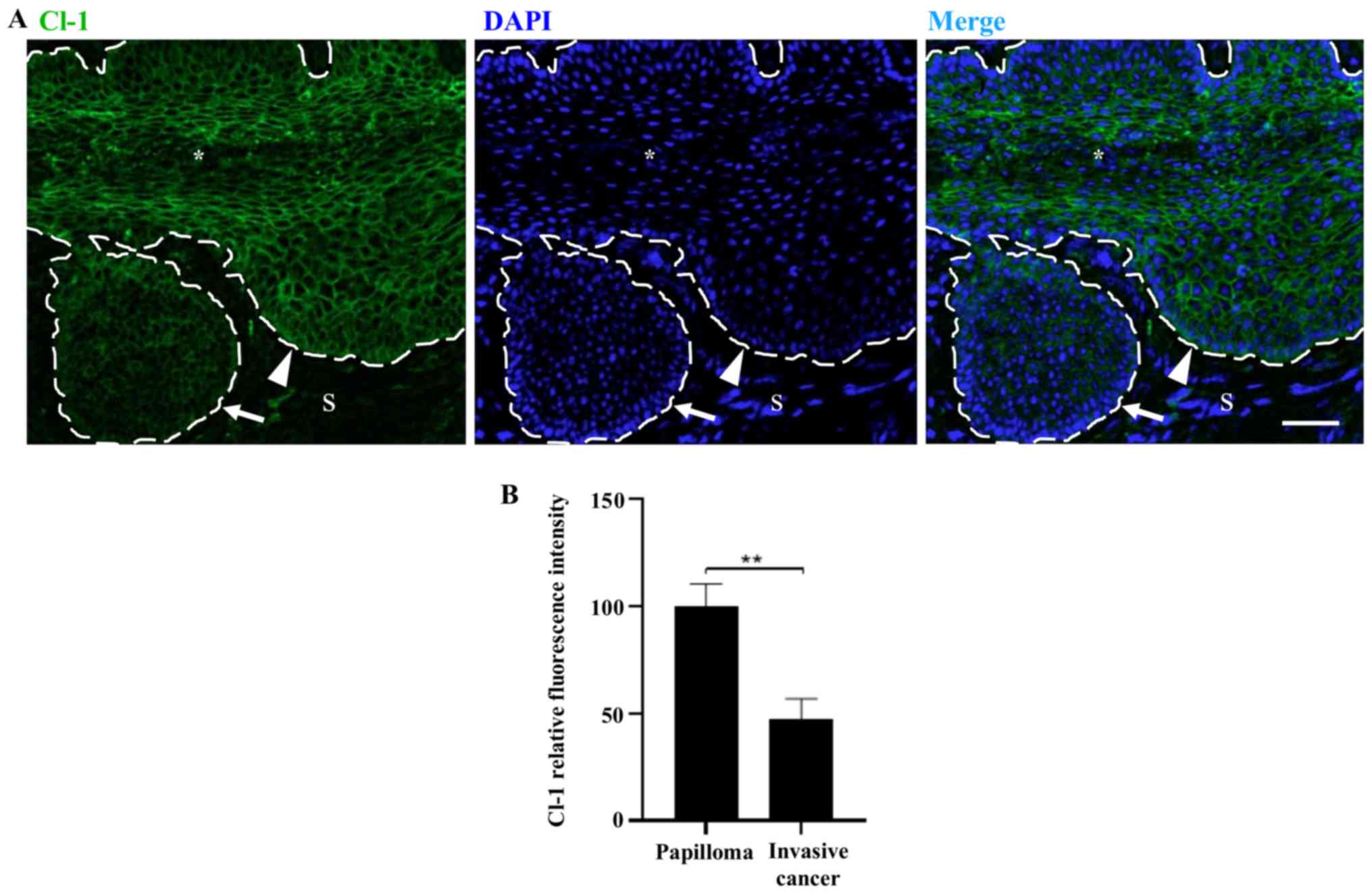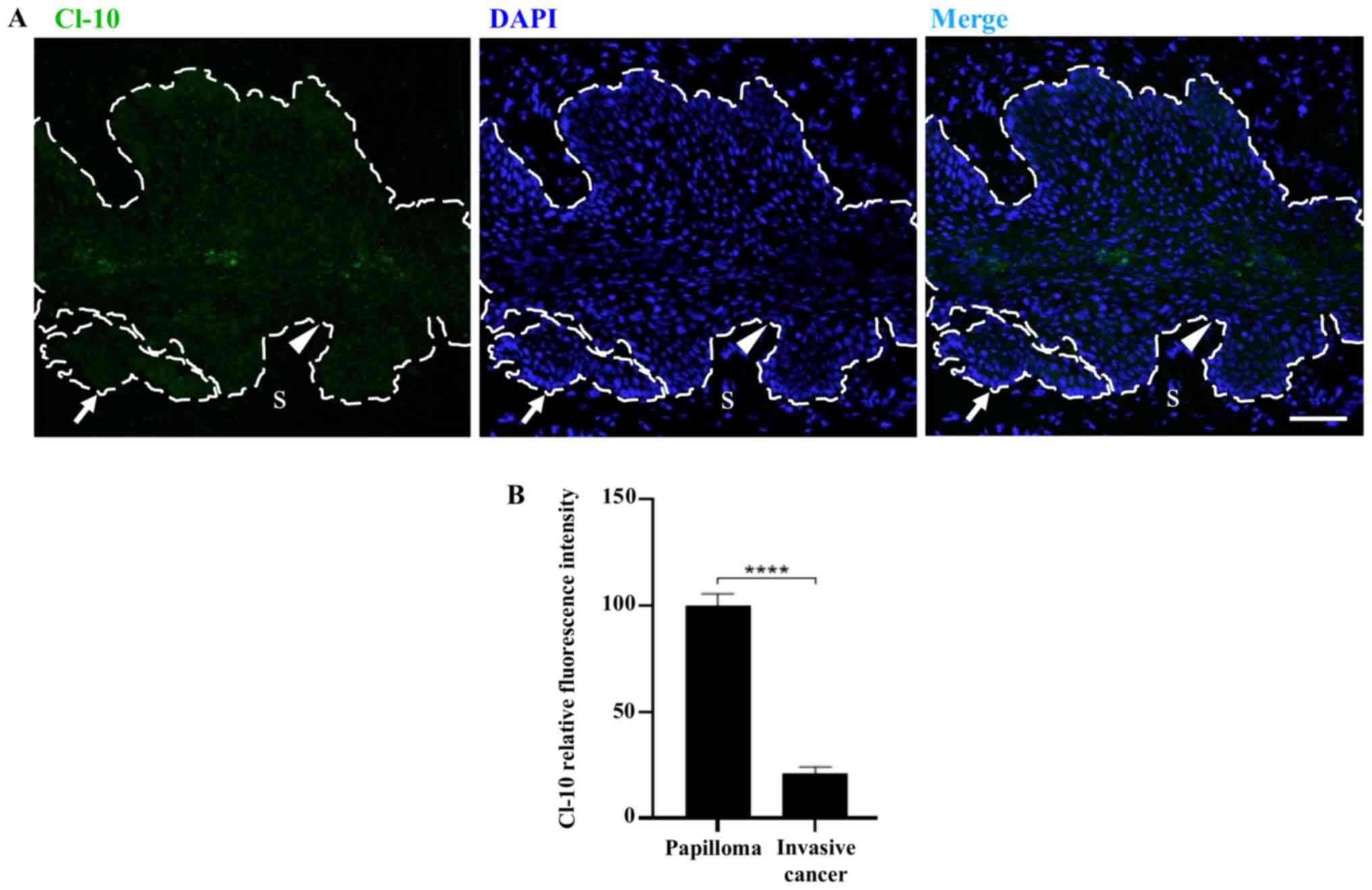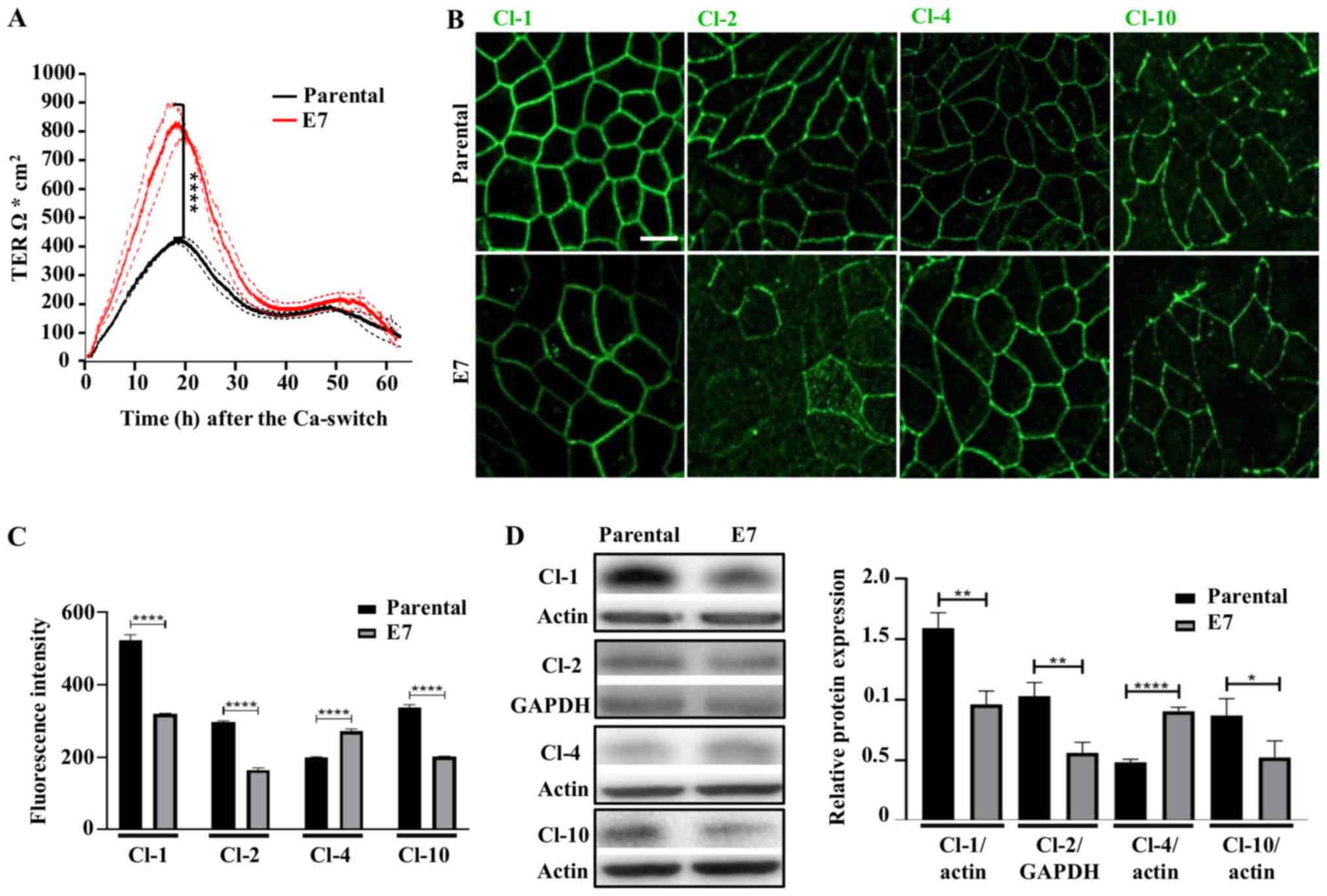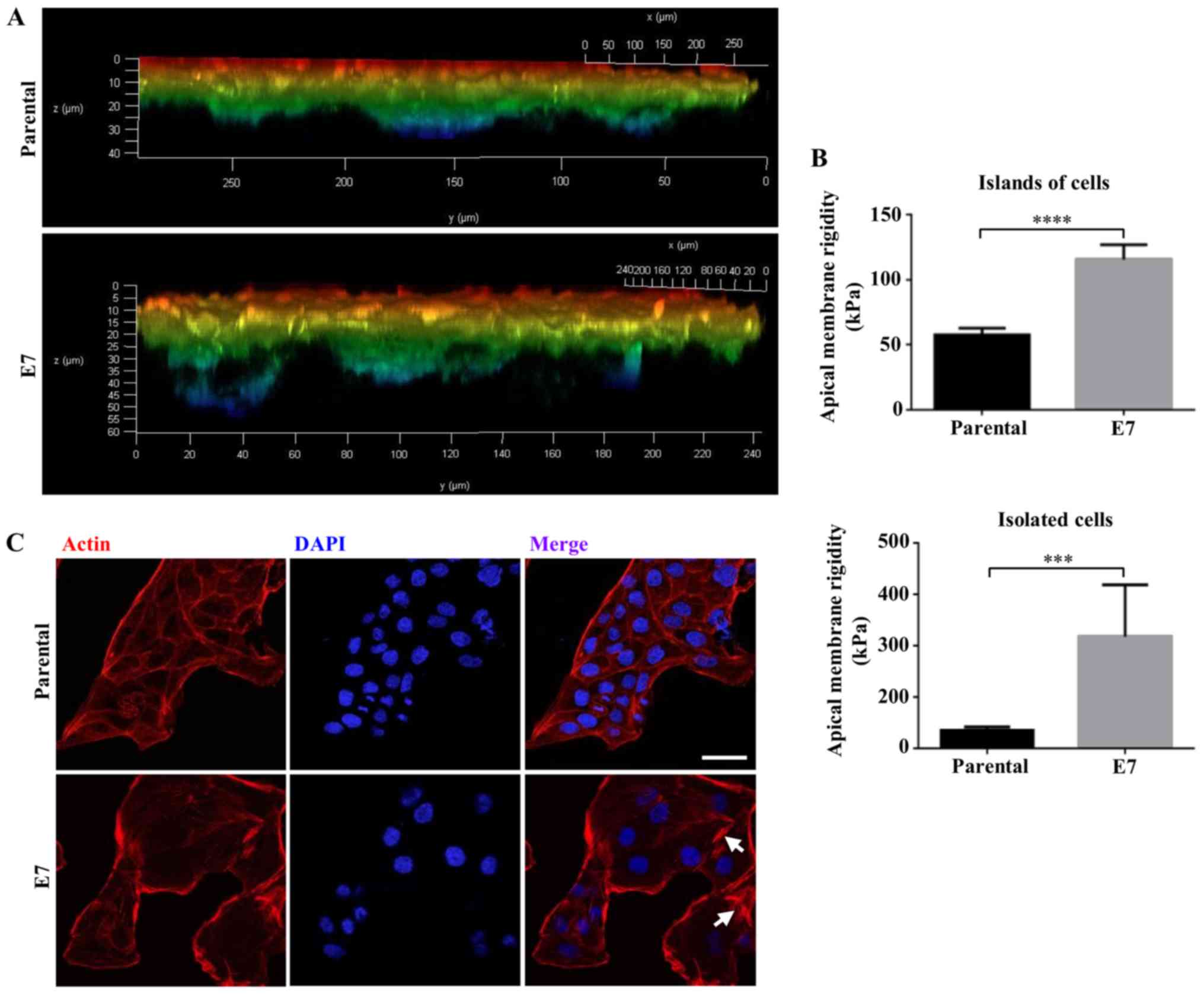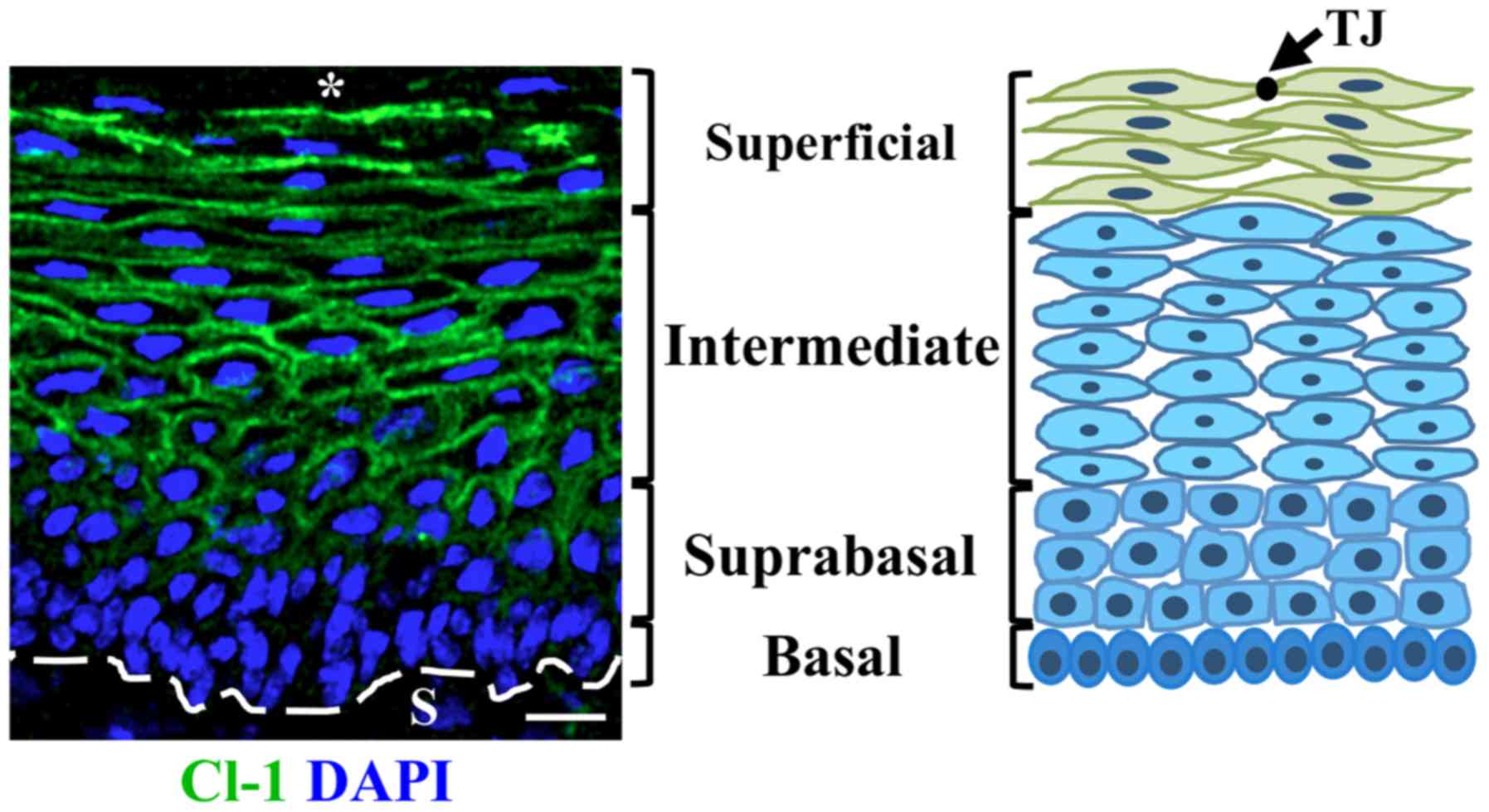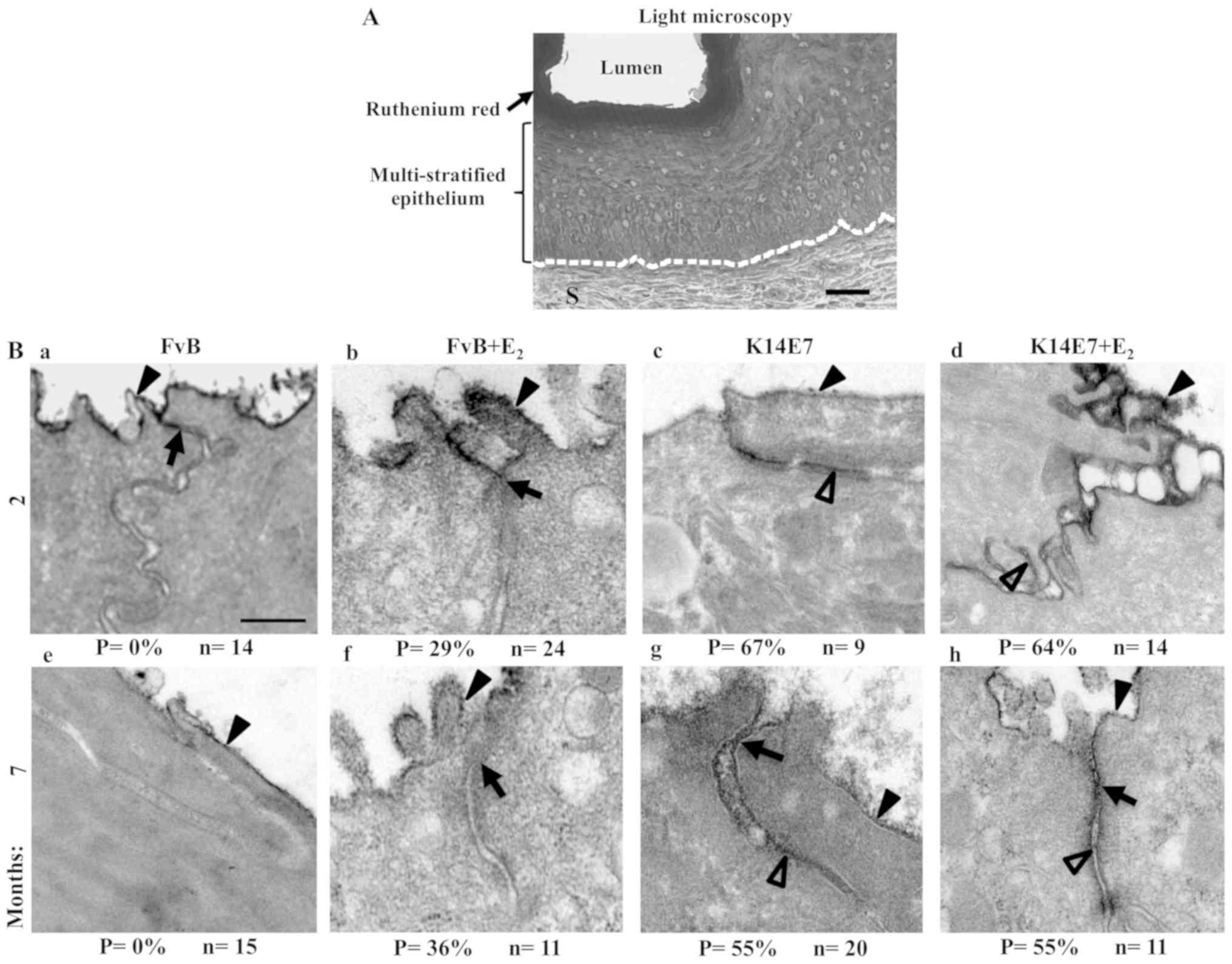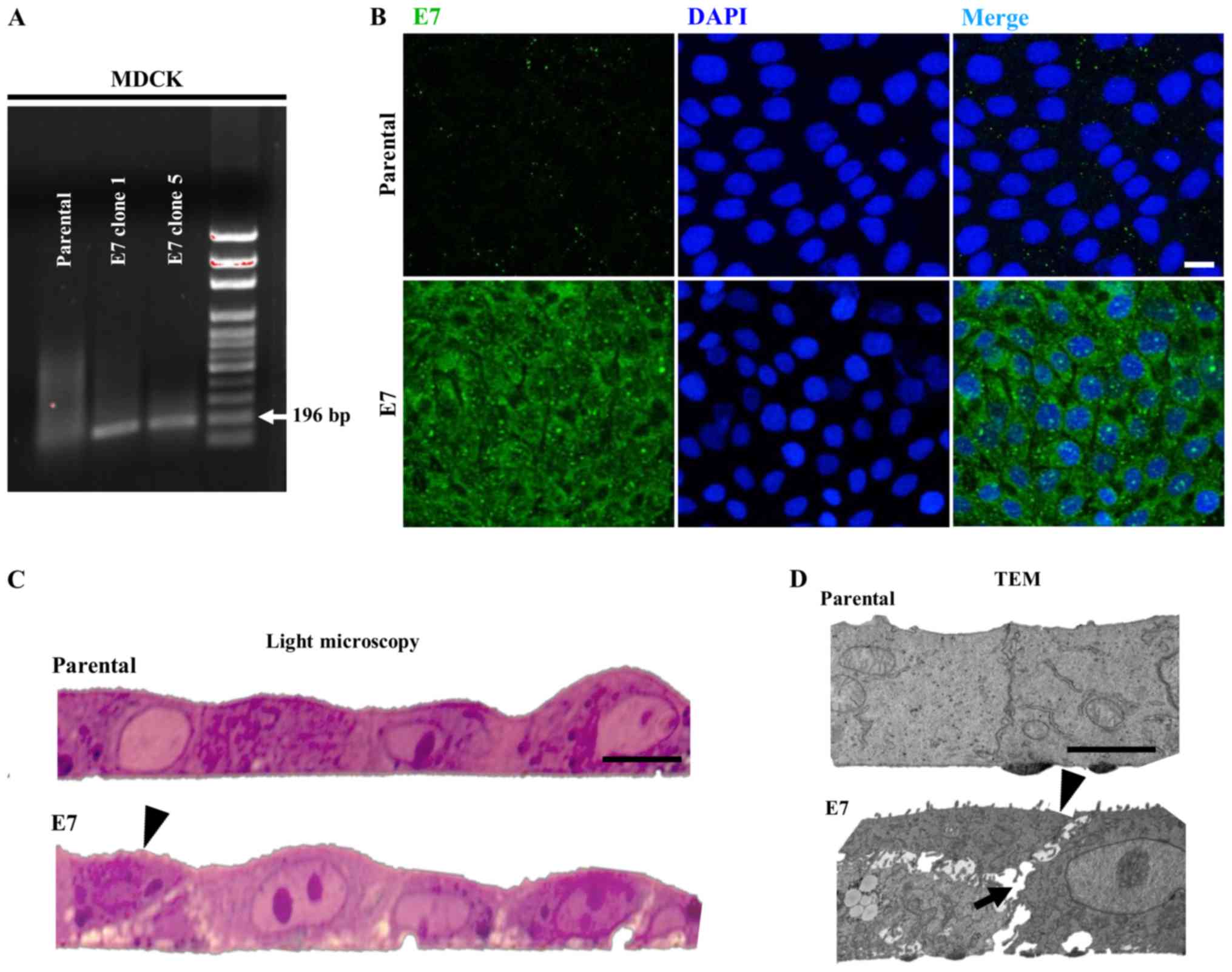|
1
|
Bray F, Ferlay J, Soerjomataram I, Siegel
RL, Torre LA and Jemal A: Global cancer statistics 2018: GLOBOCAN
estimates of incidence and mortality worldwide for 36 cancers in
185 countries. CA Cancer J Clin. 68:394–424. 2018. View Article : Google Scholar : PubMed/NCBI
|
|
2
|
Siegel RL, Miller KD and Jemal A: Cancer
statistics, 2020. CA Cancer J Clin. 70:7–30. 2020. View Article : Google Scholar : PubMed/NCBI
|
|
3
|
Jemal A, Ward EM, Johnson CJ, Cronin KA,
Ma J, Ryerson B, Mariotto A, Lake AJ, Wilson R, Sherman RL, et al:
Annual Report to the Nation on the Status of Cancer, 1975-2014
Featuring Survival. J Natl Cancer Inst. 109:1092017. View Article : Google Scholar
|
|
4
|
Paavonen J, Naud P, Salmerón J, Wheeler
CM, Chow SN, Apter D, Kitchener H, Castellsague X, Teixeira JC,
Skinner SR, et al HPV PATRICIA Study Group: Efficacy of human
papillomavirus (HPV)-16/18 AS04-adjuvanted vaccine against cervical
infection and precancer caused by oncogenic HPV types (PATRICIA):
Final analysis of a double-blind, randomised study in young women.
Lancet. 374:301–314. 2009. View Article : Google Scholar : PubMed/NCBI
|
|
5
|
Muñoz JP, Carrillo-Beltrán D,
Aedo-Aguilera V, Calaf GM, León O, Maldonado E, Tapia JC, Boccardo
E, Ozbun MA and Aguayo F: Tobacco Exposure Enhances Human
Papillomavirus 16 Oncogene Expression via EGFR/PI3K/Akt/c-Jun
Signaling Pathway in Cervical Cancer Cells. Front Microbiol.
9:30222018. View Article : Google Scholar
|
|
6
|
Muñoz N, Franceschi S, Bosetti C, Moreno
V, Herrero R, Smith JS, Shah KV, Meijer CJ and Bosch FX;
International Agency for Research on Cancer: Multicentric Cervical
Cancer Study Group: Role of parity and human papillomavirus in
cervical cancer: The IARC multicentric case-control study. Lancet.
359:1093–1101. 2002. View Article : Google Scholar
|
|
7
|
Berraho M, Amarti-Riffi A, El-Mzibri M,
Bezad R, Benjaafar N, Benideer A, Matar N, Qmichou Z, Abda N,
Attaleb M, et al: HPV and cofactors for invasive cervical cancer in
Morocco: A multicentre case-control study. BMC Cancer. 17:4352017.
View Article : Google Scholar : PubMed/NCBI
|
|
8
|
Chung SH, Franceschi S and Lambert PF:
Estrogen and ERalpha: Culprits in cervical cancer? Trends
Endocrinol Metab. 21:504–511. 2010. View Article : Google Scholar : PubMed/NCBI
|
|
9
|
Asthana S, Busa V and Labani S: Oral
contraceptives use and risk of cervical cancer-A systematic review
& meta-analysis. Eur J Obstet Gynecol Reprod Biol. 247:163–175.
2020. View Article : Google Scholar : PubMed/NCBI
|
|
10
|
Mapanga W, Singh E, Feresu SA and
Girdler-Brown B: Treatment of pre- and confirmed cervical cancer in
HIV-seropositive women from developing countries: A systematic
review. Syst Rev. 9:792020. View Article : Google Scholar : PubMed/NCBI
|
|
11
|
Du GH, Wang JK, Richards JR and Wang JJ:
Genetic poly-morphisms in tumor necrosis factor alpha and
interleukin-10 are associated with an increased risk of cervical
cancer. Int Immunopharmacol. 66:154–161. 2019. View Article : Google Scholar
|
|
12
|
Zhang L, Tian S, Pei M, Zhao M, Wang L,
Jiang Y, Yang T, Zhao J, Song L and Yang X: Crosstalk between
histone modification and DNA methylation orchestrates the
epigenetic regulation of the costimulatory factors, Tim-3 and
galectin-9, in cervical cancer. Oncol Rep. 42:2655–2669.
2019.PubMed/NCBI
|
|
13
|
List HJ, Patzel V, Zeidler U, Schopen A,
Rühl G, Stollwerk J and Klock G: Methylation sensitivity of the
enhancer from the human papillomavirus type 16. J Biol Chem.
269:11902–11911. 1994.PubMed/NCBI
|
|
14
|
Chih HJ, Lee AH, Colville L, Binns CW and
Xu D: A review of dietary prevention of human
papillomavirus-related infection of the cervix and cervical
intraepithelial neoplasia. Nutr Cancer. 65:317–328. 2013.
View Article : Google Scholar : PubMed/NCBI
|
|
15
|
Ghosh C, Baker JA, Moysich KB, Rivera R,
Brasure JR and McCann SE: Dietary intakes of selected nutrients and
food groups and risk of cervical cancer. Nutr Cancer. 60:331–341.
2008. View Article : Google Scholar : PubMed/NCBI
|
|
16
|
Song S, Liem A, Miller JA and Lambert PF:
Human papillomavirus types 16 E6 and E7 contribute differently to
carcinogenesis. Virology. 267:141–150. 2000. View Article : Google Scholar : PubMed/NCBI
|
|
17
|
Werness BA, Levine AJ and Howley PM:
Association of human papillomavirus types 16 and 18 E6 proteins
with p53. Science. 248:76–79. 1990. View Article : Google Scholar : PubMed/NCBI
|
|
18
|
Dyson N, Howley PM, Münger K and Harlow E:
The human papilloma virus-16 E7 oncoprotein is able to bind to the
retinoblastoma gene product. Science. 243:934–937. 1989. View Article : Google Scholar : PubMed/NCBI
|
|
19
|
Riley RR, Duensing S, Brake T, Münger K,
Lambert PF and Arbeit JM: Dissection of human papillomavirus E6 and
E7 function in transgenic mouse models of cervical carcinogenesis.
Cancer Res. 63:4862–4871. 2003.PubMed/NCBI
|
|
20
|
Brake T, Connor JP, Petereit DG and
Lambert PF: Comparative analysis of cervical cancer in women and in
a human papillomavirus-transgenic mouse model: Identification of
mini-chromosome maintenance protein 7 as an informative biomarker
for human cervical cancer. Cancer Res. 63:8173–8180.
2003.PubMed/NCBI
|
|
21
|
Arbeit JM, Howley PM and Hanahan D:
Chronic estrogen-induced cervical and vaginal squamous
carcinogenesis in human papillomavirus type 16 transgenic mice.
Proc Natl Acad Sci USA. 93:2930–2935. 1996. View Article : Google Scholar : PubMed/NCBI
|
|
22
|
Brake T and Lambert PF: Estrogen
contributes to the onset, persistence, and malignant progression of
cervical cancer in a human papillomavirus-transgenic mouse model.
Proc Natl Acad Sci USA. 102:2490–2495. 2005. View Article : Google Scholar : PubMed/NCBI
|
|
23
|
González-Mariscal L, Díaz-Coránguez M and
Quirós M: Regulation of tight junctions for therapeutic advanges.
Cancer Metastasis-Biology and Treatment. Martin TA and Jiang WG:
Springer; Dondrecht: pp. 197–246. 2013, View Article : Google Scholar
|
|
24
|
González-Mariscal L, Lechuga S and Garay
E: Role of tight junctions in cell proliferation and cancer. Prog
Histochem Cytochem. 42:1–57. 2007. View Article : Google Scholar : PubMed/NCBI
|
|
25
|
Birks DK, Kleinschmidt-DeMasters BK,
Donson AM, Barton VN, McNatt SA, Foreman NK and Handler MH: Claudin
6 is a positive marker for atypical teratoid/rhabdoid tumors. Brain
Pathol. 20:140–150. 2010. View Article : Google Scholar
|
|
26
|
Cortés-Malagón EM, Bonilla-Delgado J,
Díaz-Chávez J, Hidalgo-Miranda A, Romero-Cordoba S, Uren A, Celik
H, McCormick M, Munguía-Moreno JA, Ibarra-Sierra E, et al: Gene
expression profile regulated by the HPV16 E7 oncoprotein and
estradiol in cervical tissue. Virology. 447:155–165. 2013.
View Article : Google Scholar : PubMed/NCBI
|
|
27
|
Seo HW, Rengaraj D, Choi JW, Ahn SE, Song
YS, Song G and Han JY: Claudin 10 is a glandular epithelial marker
in the chicken model as human epithelial ovarian cancer. Int J
Gynecol Cancer. 20:1465–1473. 2010.
|
|
28
|
Huang GW, Ding X, Chen SL and Zeng L:
Expression of claudin 10 protein in hepatocellular carcinoma:
Impact on survival. J Cancer Res Clin Oncol. 137:1213–1218. 2011.
View Article : Google Scholar : PubMed/NCBI
|
|
29
|
Zhou Y, Xiang J, Bhandari A, Guan Y, Xia
E, Zhou X, Wang Y and Wang O: CLDN10 is Associated with Papillary
Thyroid Cancer Progression. J Cancer. 9:4712–4717. 2018. View Article : Google Scholar : PubMed/NCBI
|
|
30
|
Bulut G, Fallen S, Beauchamp EM, Drebing
LE, Sun J, Berry DL, Kallakury B, Crum CP, Toretsky JA, Schlegel R,
et al: Beta-catenin accelerates human papilloma virus type-16
mediated cervical carcinogenesis in transgenic mice. PLoS One.
6:e272432011. View Article : Google Scholar : PubMed/NCBI
|
|
31
|
González-Mariscal L, Garay E and Quirós M:
Identification of claudins by western blot and immunofluorescence
in different cell lines and tissues. Methods Mol Biol. 762:213–231.
2011. View Article : Google Scholar : PubMed/NCBI
|
|
32
|
Lee C and Laimins LA: The
differentiation-dependent life cycle of human papillomaviruses in
keratinocytes. The Papillomaviruses. Garcea RL and DiMaio D:
Springer; US, Boston, MA: pp. 45–67. 2007, View Article : Google Scholar
|
|
33
|
Günzel D, Stuiver M, Kausalya PJ, Haisch
L, Krug SM, Rosenthal R, Meij IC, Hunziker W, Fromm M and Müller D:
Claudin-10 exists in six alternatively spliced isoforms that
exhibit distinct localization and function. J Cell Sci.
122:1507–1517. 2009. View Article : Google Scholar : PubMed/NCBI
|
|
34
|
Miranda J, Martín-Tapia D,
Valdespino-Vázquez Y, Alarcón L, Espejel-Nuñez A, Guzmán-Huerta M,
Muñoz-Medina JE, Shibayama M, Chávez-Munguía B, Estrada-Gutiérrez
G, et al: Syncytiotrophoblast of Placentae from Women with Zika
Virus Infection Has Altered Tight Junction Protein Expression and
Increased Paracellular Permeability. Cells. 8:82019. View Article : Google Scholar
|
|
35
|
Ortega-Olvera JM, Winkler R,
Quintanilla-Vega B, Shibayama M, Chávez-Munguía B, Martín-Tapia D,
Alarcón L and González-Mariscal L: The organophosphate pesticide
methami-dophos opens the blood-testis barrier and covalently binds
to ZO-2 in mice. Toxicol Appl Pharmacol. 360:257–272. 2018.
View Article : Google Scholar : PubMed/NCBI
|
|
36
|
Gutiérrez J, García-Villa E,
Ocadiz-Delgado R, Cortés-Malagón EM, Vázquez J, Roman-Rosales A,
Alvarez-Rios E, Celik H, Romano MC, Üren A, et al: Human
papillomavirus type 16 E7 oncoprotein upregulates the retinoic acid
receptor-beta expression in cervical cancer cell lines and K14E7
transgenic mice. Mol Cell Biochem. 408:261–272. 2015. View Article : Google Scholar : PubMed/NCBI
|
|
37
|
McFarland DC: Preparation of pure cell
cultures by cloning. Methods Cell Sci. 22:63–66. 2000. View Article : Google Scholar : PubMed/NCBI
|
|
38
|
Gonzalez-Mariscal L, Chávez de Ramírez B
and Cereijido M: Tight junction formation in cultured epithelial
cells (MDCK). J Membr Biol. 86:113–125. 1985. View Article : Google Scholar : PubMed/NCBI
|
|
39
|
Her nández-Monge J, Ga ray E, Raya-Sandino
A, Vargas-Sierra O, Díaz-Chávez J, Popoca-Cuaya M, Lambert PF,
González-Mariscal L and Gariglio P: Papillomavirus E6 oncoprotein
up-regulates occludin and ZO-2 expression in ovariectomized mice
epidermis. Exp Cell Res. 319:2588–2603. 2013. View Article : Google Scholar
|
|
40
|
Latorre IJ, Roh MH, Frese KK, Weiss RS,
Margolis B and Javier RT: Viral oncoprotein-induced mislocalization
of select PDZ proteins disrupts tight junctions and causes polarity
defects in epithelial cells. J Cell Sci. 118:4283–4293. 2005.
View Article : Google Scholar : PubMed/NCBI
|
|
41
|
Ramirez L, Betanzos A, Raya-Sandino A,
González-Mariscal L and Del Angel RM: Dengue virus enters and exits
epithelial cells through both apical and basolateral surfaces and
perturbs the apical junctional complex. Virus Res. 258:39–49. 2018.
View Article : Google Scholar : PubMed/NCBI
|
|
42
|
Nava P, López S, Arias CF, Islas S and
González-Mariscal L: The rotavirus surface protein VP8 modulates
the gate and fence function of tight junctions in epithelial cells.
J Cell Sci. 117:5509–5519. 2004. View Article : Google Scholar : PubMed/NCBI
|
|
43
|
Svensson L, Finlay BB, Bass D, von
Bonsdorff CH and Greenberg HB: Symmetric infection of rotavirus on
polarized human intestinal epithelial (Caco-2) cells. J Virol.
65:4190–4197. 1991. View Article : Google Scholar : PubMed/NCBI
|
|
44
|
Amasheh S, Meiri N, Gitter AH, Schöneberg
T, Mankertz J, Schulzke JD and Fromm M: Claudin-2 expression
induces cation-selective channels in tight junctions of epithelial
cells. J Cell Sci. 115:4969–4976. 2002. View Article : Google Scholar : PubMed/NCBI
|
|
45
|
Yu AS, Cheng MH, Angelow S, Günzel D,
Kanzawa SA, Schneeberger EE, Fromm M and Coalson RD: Molecular
basis for cation selectivity in claudin-2-based paracellular pores:
Identification of an electrostatic interaction site. J Gen Physiol.
133:111–127. 2009. View Article : Google Scholar :
|
|
46
|
Van Itallie CM, Fanning AS and Anderson
JM: Reversal of charge selectivity in cation or anion-selective
epithelial lines by expression of different claudins. Am J Physiol
Renal Physiol. 285:F1078–F1084. 2003. View Article : Google Scholar : PubMed/NCBI
|
|
47
|
Furuse M, Furuse K, Sasaki H and Tsukita
S: Conversion of zonulae occludentes from tight to leaky strand
type by introducing claudin-2 into Madin-Darby canine kidney I
cells. J Cell Biol. 153:263–272. 2001. View Article : Google Scholar : PubMed/NCBI
|
|
48
|
Van Itallie C, Rahner C and Anderson JM:
Regulated expression of claudin-4 decreases paracellular
conductance through a selective decrease in sodium permeability. J
Clin Invest. 107:1319–1327. 2001. View Article : Google Scholar : PubMed/NCBI
|
|
49
|
Hou J, Renigunta A, Yang J and Waldegger
S: Claudin-4 forms paracellular chloride channel in the kidney and
requires claudin-8 for tight junction localization. Proc Natl Acad
Sci USA. 107:18010–18015. 2010. View Article : Google Scholar : PubMed/NCBI
|
|
50
|
Chaicharoenaudomrung N, Kunhorm P and
Noisa P: Three-dimensional cell culture systems as an in vitro
platform for cancer and stem cell modeling. World J Stem Cells.
11:1065–1083. 2019. View Article : Google Scholar : PubMed/NCBI
|
|
51
|
Tavares S, Vieira AF, Taubenberger AV,
Araújo M, Martins NP, Brás-Pereira C, Polónia A, Herbig M, Barreto
C, Otto O, et al: Actin stress fiber organization promotes cell
stiffening and proliferation of pre-invasive breast cancer cells.
Nat Commun. 8:152372017. View Article : Google Scholar : PubMed/NCBI
|
|
52
|
Herber R, Liem A, Pitot H and Lambert PF:
Squamous epithelial hyperplasia and carcinoma in mice transgenic
for the human papillomavirus type 16 E7 oncogene. J Virol.
70:1873–1881. 1996. View Article : Google Scholar : PubMed/NCBI
|
|
53
|
Sobel G, Szabó I, Páska C, Kiss A,
Kovalszky I, Kádár A, Paulin F and Schaff Z: Changes of cell
adhesion and extracellular matrix (ECM) components in cervical
intraepithelial neoplasia. Pathol Oncol Res. 11:26–31. 2005.
View Article : Google Scholar : PubMed/NCBI
|
|
54
|
Chen Y, Miller C, Mosher R, Zhao X, Deeds
J, Morrissey M, Bryant B, Yang D, Meyer R, Cronin F, et al:
Identification of cervical cancer markers by cDNA and tissue
microarrays. Cancer Res. 63:1927–1935. 2003.PubMed/NCBI
|
|
55
|
Zinner B, Gyöngyösi B, Babarczi E, Kiss A
and Sobel G: Claudin 1 expression characterizes human uterine
cervical reserve cells. J Histochem Cytochem. 61:880–888. 2013.
View Article : Google Scholar : PubMed/NCBI
|
|
56
|
Sobel G, Páska C, Szabó I, Kiss A, Kádár A
and Schaff Z: Increased expression of claudins in cervical squamous
intraepithelial neoplasia and invasive carcinoma. Hum Pathol.
36:162–169. 2005. View Article : Google Scholar : PubMed/NCBI
|
|
57
|
Ersoz S, Mungan S, Cobanoglu U, Turgutalp
H and Ozoran Y: Prognostic importance of Claudin-1 and Claudin-4
expression in colon carcinomas. Pathol Res Pract. 207:285–289.
2011. View Article : Google Scholar : PubMed/NCBI
|
|
58
|
Süren D, Yıldırım M, Kaya V, Alikanoğlu
AS, Bülbüller N, Yıldız M and Sezer C: Loss of tight junction
proteins (Claudin 1, 4, and 7) correlates with aggressive behavior
in colorectal carcinoma. Med Sci Monit. 20:1255–1262. 2014.
View Article : Google Scholar : PubMed/NCBI
|
|
59
|
Jung H, Jun KH, Jung JH, Chin HM and Park
WB: The expression of claudin-1, claudin-2, claudin-3, and
claudin-4 in gastric cancer tissue. J Surg Res. 167:e185–e191.
2011. View Article : Google Scholar
|
|
60
|
Wang H and Yang X: The expression patterns
of tight junction protein claudin-1, -3, and -4 in human gastric
neoplasms and adjacent non-neoplastic tissues. Int J Clin Exp
Pathol. 8:881–887. 2015.PubMed/NCBI
|
|
61
|
Tokuhara Y, Morinishi T, Matsunaga T,
Ohsaki H, Kushida Y, Haba R and Hirakawa E: Claudin-1, but not
claudin-4, exhibits differential expression patterns between well-
to moderately-differentiated and poorly-differentiated gastric
adenocarcinoma. Oncol Lett. 10:93–98. 2015. View Article : Google Scholar : PubMed/NCBI
|
|
62
|
Lourenço SV, Coutinho-Camillo CM, Buim ME,
Pereira CM, Carvalho AL, Kowalski LP and Soares FA: Oral squamous
cell carcinoma: Status of tight junction claudins in the different
histopathological patterns and relationship with clinical
parameters. A tissue-microarray-based study of 136 cases. J Clin
Pathol. 63:609–614. 2010. View Article : Google Scholar : PubMed/NCBI
|
|
63
|
Tzelepi VN, Tsamandas AC, Vlotinou HD,
Vagianos CE and Scopa CD: Tight junctions in thyroid
carcinogenesis: Diverse expression of claudin-1, claudin-4,
claudin-7 and occludin in thyroid neoplasms. Mod Pathol. 21:22–30.
2008. View Article : Google Scholar
|
|
64
|
Székely E, Törzsök P, Riesz P, Korompay A,
Fintha A, Székely T, Lotz G, Nyirády P, Romics I, Tímár J, et al:
Expression of claudins and their prognostic significance in
noninvasive urothelial neoplasms of the human urinary bladder. J
Histochem Cytochem. 59:932–941. 2011. View Article : Google Scholar : PubMed/NCBI
|
|
65
|
Resnick MB, Konkin T, Routhier J, Sabo E
and Pricolo VE: Claudin-1 is a strong prognostic indicator in stage
II colonic cancer: A tissue microarray study. Mod Pathol.
18:511–518. 2005. View Article : Google Scholar
|
|
66
|
Shibutani M, Noda E, Maeda K, Nagahara H,
Ohtani H and Hirakawa K: Low expression of claudin-1 and presence
of poorly-differentiated tumor clusters correlate with poor
prognosis in colorectal cancer. Anticancer Res. 33:3301–3306.
2013.PubMed/NCBI
|
|
67
|
Jiang L, Yang L, Huang H, Liu BY and Zu G:
Prognostic and clinical significance of claudin-1 in colorectal
cancer: A systemic review and meta-analysis. Int J Surg.
39:214–220. 2017. View Article : Google Scholar : PubMed/NCBI
|
|
68
|
Higashi Y, Suzuki S, Sakaguchi T, Nakamura
T, Baba S, Reinecker HC, Nakamura S and Konno H: Loss of claudin-1
expression correlates with malignancy of hepatocellular carcinoma.
J Surg Res. 139:68–76. 2007. View Article : Google Scholar : PubMed/NCBI
|
|
69
|
Bouchagier KA, Assimakopoulos SF, Karavias
DD, Maroulis I, Tzelepi V, Kalofonos H, Karavias DD, Kardamakis D,
Scopa CD and Tsamandas AC: Expression of claudins-1, -4, -5, -7 and
occludin in hepatocellular carcinoma and their relation with
classic clinicopathological features and patients' survival. In
Vivo. 28:315–326. 2014.PubMed/NCBI
|
|
70
|
Sheehan GM, Kallakury BV, Sheehan CE,
Fisher HA, Kaufman RP Jr and Ross JS: Loss of claudins-1 and -7 and
expression of claudins-3 and -4 correlate with prognostic variables
in prostatic adenocarcinomas. Hum Pathol. 38:564–569. 2007.
View Article : Google Scholar : PubMed/NCBI
|
|
71
|
Chao YC, Pan SH, Yang SC, Yu SL, Che TF,
Lin CW, Tsai MS, Chang GC, Wu CH, Wu YY, et al: Claudin-1 is a
metastasis suppressor and correlates with clinical outcome in lung
adeno-carcinoma. Am J Respir Crit Care Med. 179:123–133. 2009.
View Article : Google Scholar
|
|
72
|
Moldvay J, Fábián K, Jäckel M, Németh Z,
Bogos K, Furák J, Tiszlavicz L, Fillinger J, Döme B and Schaff Z:
Claudin-1 Protein Expression Is a Good Prognostic Factor in
Non-Small Cell Lung Cancer, but only in Squamous Cell Carcinoma
Cases. Pathol Oncol Res. 23:151–156. 2017. View Article : Google Scholar
|
|
73
|
Blanchard AA, Skliris GP, Watson PH,
Murphy LC, Penner C, Tomes L, Young TL, Leygue E and Myal Y:
Claudins 1, 3 and 4 protein expression in ER negative breast cancer
correlates with markers of the basal phenotype. Virchows Arch.
454:647–656. 2009. View Article : Google Scholar : PubMed/NCBI
|
|
74
|
Kulka J, Szász AM, Németh Z, Madaras L,
Schaff Z, Molnár IA and Tokés AM: Expression of tight junction
protein claudin-4 in basal-like breast carcinomas. Pathol Oncol
Res. 15:59–64. 2009. View Article : Google Scholar
|
|
75
|
Ma F, Ding X, Fan Y, Ying J, Zheng S, Lu N
and Xu B: A CLDN1-negative phenotype predicts poor prognosis in
triple-negative breast cancer. PLoS One. 9:e1127652014. View Article : Google Scholar : PubMed/NCBI
|
|
76
|
Morohashi S, Kusumi T, Sato F, Odagiri H,
Chiba H, Yoshihara S, Hakamada K, Sasaki M and Kijima H: Decreased
expression of claudin-1 correlates with recurrence status in breast
cancer. Int J Mol Med. 20:139–143. 2007.PubMed/NCBI
|
|
77
|
Szasz AM, Tokes AM, Micsinai M, Krenacs T,
Jakab C, Lukacs L, Nemeth Z, Baranyai Z, Dede K, Madaras L, et al:
Prognostic significance of claudin expression changes in breast
cancer with regional lymph node metastasis. Clin Exp Metastasis.
28:55–63. 2011. View Article : Google Scholar
|
|
78
|
Steinau M, Rajeevan MS, Lee DR, Ruffin MT,
Horowitz IR, Flowers LC, Tadros T, Birdsong G, Husain M, Kmak DC,
et al: Evaluation of RNA markers for early detection of cervical
neoplasia in exfoliated cervical cells. Cancer Epidemiol Biomarkers
Prev. 16:295–301. 2007. View Article : Google Scholar : PubMed/NCBI
|
|
79
|
Vázquez-Ortíz G, Ciudad CJ, Piña P,
Vazquez K, Hidalgo A, Alatorre B, Garcia JA, Salamanca F,
Peralta-Rodriguez R, Rangel A, et al: Gene identification by cDNA
arrays in HPV-positive cervical cancer. Arch Med Res. 36:448–458.
2005. View Article : Google Scholar : PubMed/NCBI
|
|
80
|
Benczik M, Galamb Á, Koiss R, Kovács A,
Járay B, Székely T, Szekerczés T, Schaff Z, Sobel G and Jeney C:
Claudin-1 as a Biomarker of Cervical Cytology and Histology. Pathol
Oncol Res. 22:179–188. 2016. View Article : Google Scholar
|
|
81
|
Hoellen F, Waldmann A, Banz-Jansen C,
Holtrich U, Karn T, Oberländer M, Habermann JK, Hörmann M, Köster
F, Ribbat-Idel J, et al: Claudin-1 expression in cervical cancer.
Mol Clin Oncol. 7:880–884. 2017. View Article : Google Scholar : PubMed/NCBI
|
|
82
|
Gröne J, Weber B, Staub E, Heinze M,
Klaman I, Pilarsky C, Hermann K, Castanos-Velez E, Röpcke S, Mann
B, et al: Differential expression of genes encoding tight junction
proteins in colorectal cancer: Frequent dysregulation of claudin-1,
-8 and -12. Int J Colorectal Dis. 22:651–659. 2007. View Article : Google Scholar
|
|
83
|
Kinugasa T, Akagi Y, Yoshida T, Ryu Y,
Shiratuchi I, Ishibashi N and Shirouzu K: Increased claudin-1
protein expression contributes to tumorigenesis in ulcerative
colitis-associated colorectal cancer. Anticancer Res. 30:3181–3186.
2010.PubMed/NCBI
|
|
84
|
Dhawan P, Singh AB, Deane NG, No Y, Shiou
SR, Schmidt C, Neff J, Washington MK and Beauchamp RD: Claudin-1
regulates cellular transformation and metastatic behavior in colon
cancer. J Clin Invest. 115:1765–1776. 2005. View Article : Google Scholar : PubMed/NCBI
|
|
85
|
Aro K, Rosa LE, Bello IO, Soini Y, Mäkitie
AA, Salo T and Leivo I: Expression pattern of claudins 1 and 3-an
auxiliary tool in predicting behavior of mucoepidermoid carcinoma
of salivary gland origin. Virchows Arch. 458:341–348. 2011.
View Article : Google Scholar
|
|
86
|
Németh J, Németh Z, Tátrai P, Péter I,
Somorácz A, Szász AM, Kiss A and Schaff Z: High expression of
claudin-1 protein in papillary thyroid tumor and its regional lymph
node metastasis. Pathol Oncol Res. 16:19–27. 2010. View Article : Google Scholar
|
|
87
|
Gyorffy H: Study of claudins and
prognostic factors in some gastrointestinal diseases. Magy Onkol.
53:377–383. 2009.In Hungarian.
|
|
88
|
Montgomery E, Mamelak AJ, Gibson M, Maitra
A, Sheikh S, Amr SS, Yang S, Brock M, Forastiere A, Zhang S, et al:
Overexpression of claudin proteins in esophageal adenocar-cinoma
and its precursor lesions. Appl Immunohistochem Mol Morphol.
14:24–30. 2006. View Article : Google Scholar : PubMed/NCBI
|
|
89
|
Li W, Dong Q, Li L, Zhang Z, Cai X and Pan
X: Prognostic significance of claudin-1 and cyclin B1 protein
expression in patients with hypopharyngeal squamous cell carcinoma.
Oncol Lett. 11:2995–3002. 2016. View Article : Google Scholar : PubMed/NCBI
|
|
90
|
Li WJ, Zhang ZL, Yu XM, Cai XL, Pan XL and
Yang XY: Expression of claudin-1 and its relationship with
lymphatic microvessel generation in hypopharyngeal squamous cell
carcinoma. Genet Mol Res. 14:11814–11826. 2015. View Article : Google Scholar : PubMed/NCBI
|
|
91
|
Bello IO, Vilen ST, Niinimaa A, Kantola S,
Soini Y and Salo T: Expression of claudins 1, 4, 5, and 7 and
occludin, and relationship with prognosis in squamous cell
carcinoma of the tongue. Hum Pathol. 39:1212–1220. 2008. View Article : Google Scholar : PubMed/NCBI
|
|
92
|
Babkair H, Yamazaki M, Uddin MS, Maruyama
S, Abé T, Essa A, Sumita Y, Ahsan MS, Swelam W, Cheng J, et al:
Aberrant expression of the tight junction molecules claudin-1 and
zonula occludens-1 mediates cell growth and invasion in oral
squamous cell carcinoma. Hum Pathol. 57:51–60. 2016. View Article : Google Scholar : PubMed/NCBI
|
|
93
|
Sappayatosok K and Phattarataratip E:
Overexpression of Claudin-1 is Associated with Advanced Clinical
Stage and Invasive Pathologic Characteristics of Oral Squamous Cell
Carcinoma. Head Neck Pathol. 9:173–180. 2015. View Article : Google Scholar :
|
|
94
|
Weeraratna AT, Becker D, Carr KM, Duray
PH, Rosenblatt KP, Yang S, Chen Y, Bittner M, Strausberg RL,
Riggins GJ, et al: Generation and analysis of melanoma SAGE
libraries: SAGE advice on the melanoma transcriptome. Oncogene.
23:2264–2274. 2004. View Article : Google Scholar : PubMed/NCBI
|
|
95
|
Leotlela PD, Wade MS, Duray PH, Rhode MJ,
Brown HF, Rosenthal DT, Dissanayake SK, Earley R, Indig FE,
Nickoloff BJ, et al: Claudin-1 overexpression in melanoma is
regulated by PKC and contributes to melanoma cell motility.
Oncogene. 26:3846–3856. 2007. View Article : Google Scholar
|
|
96
|
Shiozaki A, Shimizu H, Ichikawa D, Konishi
H, Komatsu S, Kubota T, Fujiwara H, Okamoto K, Iitaka D, Nakashima
S, et al: Claudin 1 mediates tumor necrosis factor alpha-induced
cell migration in human gastric cancer cells. World J
Gastroenterol. 20:17863–17876. 2014. View Article : Google Scholar : PubMed/NCBI
|
|
97
|
Fritzsche FR, Oelrich B, Johannsen M,
Kristiansen I, Moch H, Jung K and Kristiansen G: Claudin-1 protein
expression is a prognostic marker of patient survival in renal cell
carcinomas. Clin Cancer Res. 14:7035–7042. 2008. View Article : Google Scholar : PubMed/NCBI
|
|
98
|
Huang J, Li J, Qu Y, Zhang J, Zhang L,
Chen X, Liu B and Zhu Z: The expression of claudin 1 correlates
with β-catenin and is a prognostic factor of poor outcome in
gastric cancer. Int J Oncol. 44:1293–1301. 2014. View Article : Google Scholar : PubMed/NCBI
|
|
99
|
Sun BS, Yao YQ, Pei BX, Zhang ZF and Wang
CL: Claudin-1 correlates with poor prognosis in lung
adenocarcinoma. Thorac Cancer. 7:556–563. 2016. View Article : Google Scholar : PubMed/NCBI
|
|
100
|
Zhang ZF, Pei BX, Wang AL, Zhang LM, Sun
BS, Jiang RC and Wang CL: Expressions of CLDN1 and insulin-like
growth factor 2 are associated with poor prognosis in stage N2
non-small cell lung cancer. Chin Med J (Engl). 126:3668–3674.
2013.
|
|
101
|
Hahn-Strömberg V, Askari S, Ahmad A,
Befekadu R and Nilsson TK: Expression of claudin 1, claudin 4, and
claudin 7 in colorectal cancer and its relation with CLDN DNA
methylation patterns. Tumour Biol. 39:10104283176975692017.
View Article : Google Scholar : PubMed/NCBI
|
|
102
|
Zwanziger D, Badziong J, Ting S, Moeller
LC, Schmid KW, Siebolts U, Wickenhauser C, Dralle H and Fuehrer D:
The impact of CLAUDIN-1 on follicular thyroid carcinoma
aggressiveness. Endocr Relat Cancer. 22:819–830. 2015. View Article : Google Scholar : PubMed/NCBI
|
|
103
|
Ma H, Yan J, Zhang C, Qin S, Qin L, Liu L,
Wang X and Li N: Expression of papillary thyroid
carcinoma-associated molecular markers and their significance in
follicular epithelial dysplasia with papillary thyroid
carcinoma-like nuclear alterations in Hashimoto's thyroiditis. Int
J Clin Exp Pathol. 7:7999–8007. 2014.
|
|
104
|
Abd El AttiRM and Shash LS: Potential
diagnostic utility of CD56 and claudin-1 in papillary thyroid
carcinoma and solitary follicular thyroid nodules. J Egypt Natl
Canc Inst. 24:175–184. 2012. View Article : Google Scholar
|
|
105
|
Furuse M, Hata M, Furuse K, Yoshida Y,
Haratake A, Sugitani Y, Noda T, Kubo A and Tsukita S: Claudin-based
tight junctions are crucial for the mammalian epidermal barrier: A
lesson from claudin-1-deficient mice. J Cell Biol. 156:1099–1111.
2002. View Article : Google Scholar : PubMed/NCBI
|
|
106
|
Reyes JL, Lamas M, Martin D, del Carmen
Namorado M, Islas S, Luna J, Tauc M and González-Mariscal L: The
renal segmental distribution of claudins changes with development.
Kidney Int. 62:476–487. 2002. View Article : Google Scholar : PubMed/NCBI
|
|
107
|
Lu Z, Ding L, Lu Q and Chen YH: Claudins
in intestines: Distribution and functional significance in health
and diseases. Tissue Barriers. 1:e249782013. View Article : Google Scholar
|
|
108
|
Garcia-Hernandez V, Quiros M and Nusrat A:
Intestinal epithelial claudins: Expression and regulation in
homeostasis and inflammation. Ann N Y Acad Sci. 1397:66–79. 2017.
View Article : Google Scholar : PubMed/NCBI
|
|
109
|
Tőkés AM, Szász AM, Juhász E, Schaff Z,
Harsányi L, Molnár IA, Baranyai Z, Besznyák I Jr, Zaránd A, Salamon
F, et al: Expression of tight junction molecules in breast
carcinomas analysed by array PCR and immunohistochemistry. Pathol
Oncol Res. 18:593–606. 2012. View Article : Google Scholar
|
|
110
|
Németh Z, Szász AM, Tátrai P, Németh J,
Gyorffy H, Somorácz A, Szíjártó A, Kupcsulik P, Kiss A and Schaff
Z: Claudin-1, -2, -3, -4, -7, -8, and -10 protein expression in
biliary tract cancers. J Histochem Cytochem. 57:113–121. 2009.
View Article : Google Scholar :
|
|
111
|
Zhang Z, Wang A, Sun B, Zhan Z, Chen K and
Wang C: Expression of CLDN1 and CLDN10 in lung adenocarcinoma in
situ and invasive lepidic predominant adenocarcinoma. J
Cardiothorac Surg. 8:952013. View Article : Google Scholar : PubMed/NCBI
|
|
112
|
Cheung ST, Leung KL, Ip YC, Chen X, Fong
DY, Ng IO, Fan ST and So S: Claudin-10 expression level is
associated with recurrence of primary hepatocellular carcinoma.
Clin Cancer Res. 11:551–556. 2005.PubMed/NCBI
|
|
113
|
Sanada Y, Yoshida K and Itoh H: Comparison
of CT enhancement patterns and histologic features in
hepatocellular carcinoma up to 2 cm: Assessment of malignant
potential with claudin-10 immunohistochemistry. Oncol Rep.
17:1177–1182. 2007.PubMed/NCBI
|
|
114
|
Aldred MA, Huang Y, Liyanarachchi S,
Pellegata NS, Gimm O, Jhiang S, Davuluri RV, de la Chapelle A and
Eng C: Papillary and follicular thyroid carcinomas show distinctly
different microarray expression profiles and can be distinguished
by a minimum of five genes. J Clin Oncol. 22:3531–3539. 2004.
View Article : Google Scholar : PubMed/NCBI
|
|
115
|
Barros-Filho MC, Marchi FA, Pinto CA,
Rogatto SR and Kowalski LP: High Diagnostic Accuracy Based on
CLDN10, HMGA2, and LAMB3 Transcripts in Papillary Thyroid
Carcinoma. J Clin Endocrinol Metab. 100:E890–E899. 2015. View Article : Google Scholar : PubMed/NCBI
|
|
116
|
Blaskewicz CD, Pudney J and Anderson DJ:
Structure and function of intercellular junctions in human cervical
and vaginal mucosal epithelia. Biol Reprod. 85:97–104. 2011.
View Article : Google Scholar : PubMed/NCBI
|
|
117
|
Cereijido M, Robbins ES, Dolan WJ, Rotunno
CA and Sabatini DD: Polarized monolayers formed by epithelial cells
on a permeable and translucent support. J Cell Biol. 77:853–880.
1978. View Article : Google Scholar : PubMed/NCBI
|
|
118
|
Martinez-Palomo A, Meza I, Beaty G and
Cereijido M: Experimental modulation of occluding junctions in a
cultured transporting epithelium. J Cell Biol. 87:736–745. 1980.
View Article : Google Scholar : PubMed/NCBI
|
|
119
|
Meza I, Ibarra G, Sabanero M,
Martínez-Palomo A and Cereijido M: Occluding junctions and
cytoskeletal components in a cultured transporting epithelium. J
Cell Biol. 87:746–754. 1980. View Article : Google Scholar : PubMed/NCBI
|
|
120
|
Meza I, Sabanero M, Stefani E and
Cereijido M: Occluding junctions in MDCK cells: Modulation of
transepithelial permeability by the cytoskeleton. J Cell Biochem.
18:407–421. 1982. View Article : Google Scholar : PubMed/NCBI
|
|
121
|
Cereijido M, Stefani E and Palomo AM:
Occluding junctions in a cultured transporting epithelium:
Structural and functional heterogeneity. J Membr Biol. 53:19–32.
1980. View Article : Google Scholar : PubMed/NCBI
|
|
122
|
Balda MS, Whitney JA, Flores C, González
S, Cereijido M and Matter K: Functional dissociation of
paracellular perme-ability and transepithelial electrical
resistance and disruption of the apical-basolateral intramembrane
diffusion barrier by expression of a mutant tight junction membrane
protein. J Cell Biol. 134:1031–1049. 1996. View Article : Google Scholar : PubMed/NCBI
|
|
123
|
Fanning AS, Little BP, Rahner C,
Utepbergenov D, Walther Z and Anderson JM: The unique-5 and -6
motifs of ZO-1 regulate tight junction strand localization and
scaffolding properties. Mol Biol Cell. 18:721–731. 2007. View Article : Google Scholar :
|
|
124
|
Van Itallie CM, Gambling TM, Carson JL and
Anderson JM: Palmitoylation of claudins is required for efficient
tight-junction localization. J Cell Sci. 118:1427–1436. 2005.
View Article : Google Scholar : PubMed/NCBI
|
|
125
|
Colegio OR, Van Itallie C, Rahner C and
Anderson JM: Claudin extracellular domains determine paracellular
charge selectivity and resistance but not tight junction fibril
architecture. Am J Physiol Cell Physiol. 284:C1346–C1354. 2003.
View Article : Google Scholar : PubMed/NCBI
|
|
126
|
Colegio OR, Van Itallie CM, McCrea HJ,
Rahner C and Anderson JM: Claudins create charge-selective channels
in the paracellular pathway between epithelial cells. Am J Physiol
Cell Physiol. 283:C142–C147. 2002. View Article : Google Scholar : PubMed/NCBI
|
|
127
|
González-Mariscal L, Chávez de Ramírez B
and Cereijido M: Effect of temperature on the occluding junctions
of mono-layers of epithelioid cells (MDCK). J Membr Biol.
79:175–184. 1984. View Article : Google Scholar
|
|
128
|
Gonzalez-Mariscal L, Contreras RG, Bolívar
JJ, Ponce A, Chávez De Ramirez B and Cereijido M: Role of calcium
in tight junction formation between epithelial cells. Am J Physiol.
259:C978–C986. 1990. View Article : Google Scholar : PubMed/NCBI
|
|
129
|
Contreras RG, Miller JH, Zamora M,
González-Mariscal L and Cereijido M: Interaction of calcium with
plasma membrane of epithelial (MDCK) cells during junction
formation. Am J Physiol. 263:C313–C318. 1992. View Article : Google Scholar : PubMed/NCBI
|
|
130
|
Amaya E, Alarcón L, Martín-Tapia D,
Cuellar-Pérez F, Cano-Cortina M, Ortega-Olvera JM, Cisneros B,
Rodriguez AJ, Gamba G and González-Mariscal L: Activation of the
Ca2+ sensing receptor and the PKC/WNK4 downstream
signaling cascade induces incorporation of ZO-2 to tight junctions
and its separation from 14-3-3. Mol Biol Cell. 30:2377–2398. 2019.
View Article : Google Scholar : PubMed/NCBI
|
|
131
|
Balda MS, Gonzalez-Mariscal L, Matter K,
Cereijido M and Anderson JM: Assembly of the tight junction: The
role of diacylglycerol. J Cell Biol. 123:293–302. 1993. View Article : Google Scholar : PubMed/NCBI
|
|
132
|
Balda MS, González-Mariscal L, Contreras
RG, Macias-Silva M, Torres-Marquez ME, García-Sáinz JA and
Cereijido M: Assembly and sealing of tight junctions: Possible
participation of G-proteins, phospholipase C, protein kinase C and
calmodulin. J Membr Biol. 122:193–202. 1991. View Article : Google Scholar : PubMed/NCBI
|
|
133
|
Sonoda N, Furuse M, Sasaki H, Yonemura S,
Katahira J, Horiguchi Y and Tsukita S: Clostridium perfringens
enterotoxin fragment removes specific claudins from tight junction
strands: Evidence for direct involvement of claudins in tight
junction barrier. J Cell Biol. 147:195–204. 1999. View Article : Google Scholar : PubMed/NCBI
|
|
134
|
Feldman G, Kiely B, Martin N, Ryan G,
McMorrow T and Ryan MP: Role for TGF-beta in cyclosporine-induced
modulation of renal epithelial barrier function. J Am Soc Nephrol.
18:1662–1671. 2007. View Article : Google Scholar : PubMed/NCBI
|
|
135
|
García-Hernández V, Flores-Maldonado C,
Rincon-Heredia R, Verdejo-Torres O, Bonilla-Delgado J,
Meneses-Morales I, Gariglio P and Contreras RG: EGF regulates
claudin-2 and -4 expression through Src and STAT3 in MDCK cells. J
Cell Physiol. 230:105–115. 2015. View Article : Google Scholar
|
|
136
|
Inai T, Kobayashi J and Shibata Y:
Claudin-1 contributes to the epithelial barrier function in MDCK
cells. Eur J Cell Biol. 78:849–855. 1999. View Article : Google Scholar
|
|
137
|
McCarthy KM, Francis SA, McCormack JM, Lai
J, Rogers RA, Skare IB, Lynch RD and Schneeberger EE: Inducible
expression of claudin-1-myc but not occludin-VSV-G results in
aberrant tight junction strand formation in MDCK cells. J Cell Sci.
113:3387–3398. 2000.PubMed/NCBI
|
|
138
|
Van Itallie CM, Mitic LL and Anderson JM:
Claudin-2 forms homodimers and is a component of a high molecular
weight protein complex. J Biol Chem. 286:3442–3450. 2011.
View Article : Google Scholar :
|
|
139
|
Milatz S, Piontek J, Hempel C, Meoli L,
Grohe C, Fromm A, Lee IM, El-Athman R and Günzel D: Tight junction
strand formation by claudin-10 isoforms and claudin-10a/-10b
chimeras. Ann N Y Acad Sci. 1405:102–115. 2017. View Article : Google Scholar : PubMed/NCBI
|
|
140
|
Nakagawa S and Huibregtse JM: Human
scribble (Vartul) is targeted for ubiquitin-mediated degradation by
the high-risk papillomavirus E6 proteins and the E6AP
ubiquitin-protein ligase. Mol Cell Biol. 20:8244–8253. 2000.
View Article : Google Scholar : PubMed/NCBI
|
|
141
|
Golebiewski L, Liu H, Javier RT and Rice
AP: The avian influenza virus NS1 ESEV PDZ binding motif associates
with Dlg1 and Scribble to disrupt cellular tight junctions. J
Virol. 85:10639–10648. 2011. View Article : Google Scholar : PubMed/NCBI
|
|
142
|
Johnson C, Sanders K and Fan H: Jaagsiekte
sheep retrovirus transformation in Madin-Darby canine kidney
epithelial cell three-dimensional culture. J Virol. 84:5379–5390.
2010. View Article : Google Scholar : PubMed/NCBI
|
|
143
|
Töyli M, Rosberg-Kulha L, Capra J,
Vuoristo J and Eskelinen S: Different responses in transformation
of MDCK cells in 2D and 3D culture by v-Src as revealed by
microarray techniques, RT-PCR and functional assays. Lab Invest.
90:915–928. 2010. View Article : Google Scholar : PubMed/NCBI
|
|
144
|
Mettlen M, Platek A, Van Der Smissen P,
Carpentier S, Amyere M, Lanzetti L, de Diesbach P, Tyteca D and
Courtoy PJ: Src triggers circular ruffling and macropinocytosis at
the apical surface of polarized MDCK cells. Traffic. 7:589–603.
2006. View Article : Google Scholar : PubMed/NCBI
|
|
145
|
Rahikkala M, Sormunen R and Eskelinen S:
Effects of src kinase and TGFbeta1 on the differentiation and
morphogenesis of MDCK cells grown in three-dimensional collagen and
Matrigel environments. J Pathol. 195:391–400. 2001. View Article : Google Scholar : PubMed/NCBI
|
|
146
|
Tsukamoto T and Nigam SK: Cell-cell
dissociation upon epithelial cell scattering requires a step
mediated by the proteasome. J Biol Chem. 274:24579–24584. 1999.
View Article : Google Scholar : PubMed/NCBI
|
|
147
|
Takeda H and Tsukita S: Effects of
tyrosine phosphorylation on tight junctions in
temperature-sensitive v-src-transfected MDCK cells. Cell Struct
Funct. 20:387–393. 1995. View Article : Google Scholar : PubMed/NCBI
|
|
148
|
Connolly-Andersen AM, Magnusson KE and
Mirazimi A: Basolateral entry and release of Crimean-Congo
hemorrhagic fever virus in polarized MDCK-1 cells. J Virol.
81:2158–2164. 2007. View Article : Google Scholar :
|
|
149
|
Nunbhakdi-Craig V, Craig L, Machleidt T
and Sontag E: Simian virus 40 small tumor antigen induces
deregulation of the actin cytoskeleton and tight junctions in
kidney epithelial cells. J Virol. 77:2807–2818. 2003. View Article : Google Scholar : PubMed/NCBI
|
|
150
|
Tafazoli F, Zeng CQ, Estes MK, Magnusson
KE and Svensson L: NSP4 enterotoxin of rotavirus induces
paracellular leakage in polarized epithelial cells. J Virol.
75:1540–1546. 2001. View Article : Google Scholar : PubMed/NCBI
|
|
151
|
Mo C, Schneeberger EE and Arvin AM:
Glycoprotein E of varicella-zoster virus enhances cell-cell contact
in polarized epithelial cells. J Virol. 74:11377–11387. 2000.
View Article : Google Scholar : PubMed/NCBI
|
|
152
|
Rajasekaran AK, Hojo M, Huima T and
Rodriguez-Boulan E: Catenins and zonula occludens-1 form a complex
during early stages in the assembly of tight junctions. J Cell
Biol. 132:451–463. 1996. View Article : Google Scholar : PubMed/NCBI
|
|
153
|
Gottlieb TA, Ivanov IE, Adesnik M and
Sabatini DD: Actin microfilaments play a critical role in
endocytosis at the apical but not the basolateral surface of
polarized epithelial cells. J Cell Biol. 120:695–710. 1993.
View Article : Google Scholar : PubMed/NCBI
|
|
154
|
Stephens EB, Compans RW, Earl P and Moss
B: Surface expression of viral glycoproteins is polarized in
epithelial cells infected with recombinant vaccinia viral vectors.
EMBO J. 5:237–245. 1986. View Article : Google Scholar : PubMed/NCBI
|
|
155
|
Schoenenberger CA, Zuk A, Kendall D and
Matlin KS: Multilayering and loss of apical polarity in MDCK cells
trans-formed with viral K-ras. J Cell Biol. 112:873–889. 1991.
View Article : Google Scholar : PubMed/NCBI
|
|
156
|
Gravotta D, Adesnik M and Sabatini DD:
Transport of influenza HA from the trans-Golgi network to the
apical surface of MDCK cells permeabilized in their basolateral
plasma membranes: Energy dependence and involvement of GTP-binding
proteins. J Cell Biol. 111:2893–2908. 1990. View Article : Google Scholar : PubMed/NCBI
|
|
157
|
van Meer G and Simons K: The function of
tight junctions in maintaining differences in lipid composition
between the apical and the basolateral cell surface domains of MDCK
cells. EMBO J. 5:1455–1464. 1986. View Article : Google Scholar : PubMed/NCBI
|
|
158
|
Rindler MJ, Ivanov IE, Plesken H,
Rodriguez-Boulan E and Sabatini DD: Viral glycoproteins destined
for apical or basolateral plasma membrane domains traverse the same
Golgi apparatus during their intracellular transport in doubly
infected Madin-Darby canine kidney cells. J Cell Biol.
98:1304–1319. 1984. View Article : Google Scholar : PubMed/NCBI
|
|
159
|
Roth MG and Compans RW: Delayed appearance
of pseudotypes between vesicular stomatitis virus influenza virus
during mixed infection of MDCK cells. J Virol. 40:848–860. 1981.
View Article : Google Scholar : PubMed/NCBI
|
|
160
|
Noyce RS, Delpeut S and Richardson CD: Dog
nectin-4 is an epithelial cell receptor for canine distemper virus
that facilitates virus entry and syncytia formation. Virology.
436:210–220. 2013. View Article : Google Scholar
|
|
161
|
Hernandez S, Chavez Munguia B and
Gonzalez-Mariscal L: ZO-2 silencing in epithelial cells perturbs
the gate and fence function of tight junctions and leads to an
atypical monolayer architecture. Exp Cell Res. 313:1533–1547. 2007.
View Article : Google Scholar : PubMed/NCBI
|
|
162
|
Raya-Sandino A, Castillo-Kauil A,
Domínguez-Calderón A, Alarcón L, Flores-Benitez D, Cuellar-Perez F,
López-Bayghen B, Chávez-Munguía B, Vázquez-Prado J and
González-Mariscal L: Zonula occludens-2 regulates Rho proteins
activity and the development of epithelial cytoarchitecture and
barrier function. Biochim Biophys Acta Mol Cell Res.
1864:1714–1733. 2017. View Article : Google Scholar : PubMed/NCBI
|
|
163
|
Günzel D and Yu AS: Claudins and the
modulation of tight junction permeability. Physiol Rev. 93:525–569.
2013. View Article : Google Scholar : PubMed/NCBI
|
|
164
|
Enck AH, Berger UV and Yu AS: Claudin-2 is
selectively expressed in proximal nephron in mouse kidney. Am J
Physiol Renal Physiol. 281:F966–F974. 2001. View Article : Google Scholar : PubMed/NCBI
|
|
165
|
Rahner C, Mitic LL and Anderson JM:
Heterogeneity in expression and subcellular localization of
claudins 2, 3, 4, and 5 in the rat liver, pancreas, and gut.
Gastroenterology. 120:411–422. 2001. View Article : Google Scholar : PubMed/NCBI
|
|
166
|
Van Itallie CM, Rogan S, Yu A, Vidal LS,
Holmes J and Anderson JM: Two splice variants of claudin-10 in the
kidney create paracellular pores with different ion selectivities.
Am J Physiol Renal Physiol. 291:F1288–F1299. 2006. View Article : Google Scholar : PubMed/NCBI
|
|
167
|
Ikari A, Sato T, Takiguchi A, Atomi K,
Yamazaki Y and Sugatani J: Claudin-2 knockdown decreases matrix
metallopro-teinase-9 activity and cell migration via suppression of
nuclear Sp1 in A549 cells. Life Sci. 88:628–633. 2011. View Article : Google Scholar : PubMed/NCBI
|
|
168
|
Hicks DA, Galimanis CE, Webb PG, Spillman
MA, Behbakht K, Neville MC and Baumgartner HK: Claudin-4 activity
in ovarian tumor cell apoptosis resistance and migration. BMC
Cancer. 16:7882016. View Article : Google Scholar : PubMed/NCBI
|
|
169
|
Dahiya N, Becker KG, Wood WH III, Zhang Y
and Morin PJ: Claudin-7 is frequently overexpressed in ovarian
cancer and promotes invasion. PLoS One. 6:e221192011. View Article : Google Scholar : PubMed/NCBI
|
|
170
|
Ashikari D, Takayama KI, Obinata D,
Takahashi S and Inoue S: CLDN8, an androgen-regulated gene,
promotes prostate cancer cell proliferation and migration. Cancer
Sci. 108:1386–1393. 2017. View Article : Google Scholar : PubMed/NCBI
|
|
171
|
Ip YC, Cheung ST, Lee YT, Ho JC and Fan
ST: Inhibition of hepatocellular carcinoma invasion by suppression
of claudin-10 in HLE cells. Mol Cancer Ther. 6:2858–2867. 2007.
View Article : Google Scholar : PubMed/NCBI
|
|
172
|
Sun L, Feng L and Cui J: Increased
expression of claudin-17 promotes a malignant phenotype in
hepatocyte via Tyk2/Stat3 signaling and is associated with poor
prognosis in patients with hepatocellular carcinoma. Diagn Pathol.
13:722018. View Article : Google Scholar : PubMed/NCBI
|
|
173
|
Shang X, Lin X, Alvarez E, Manorek G and
Howell SB: Tight junction proteins claudin-3 and claudin-4 control
tumor growth and metastases. Neoplasia. 14:974–985. 2012.
View Article : Google Scholar : PubMed/NCBI
|
|
174
|
Ren Y, Wu Q, Liu Y, Xu X and Quan C: Gene
silencing of claudin-6 enhances cell proliferation and migration
accompanied with increased MMP-2 activity via p38 MAPK signaling
pathway in human breast epithelium cell line HBL-100. Mol Med Rep.
8:1505–1510. 2013. View Article : Google Scholar : PubMed/NCBI
|
|
175
|
Li Y, Gong Y, Ning X, Peng D, Liu L, He S,
Gong K, Zhang C, Li X and Zhou L: Downregulation of CLDN7 due to
promoter hypermethylation is associated with human clear cell renal
cell carcinoma progression and poor prognosis. J Exp Clin Cancer
Res. 37:2762018. View Article : Google Scholar : PubMed/NCBI
|
|
176
|
Li HP, Peng CC, Wu CC, Chen CH, Shih MJ,
Huang MY, Lai YR, Chen YL, Chen TW, Tang P, et al: Inactivation of
the tight junction gene CLDN11 by aberrant hypermethylation
modulates tubulins polymerization and promotes cell migration in
nasopharyngeal carcinoma. J Exp Clin Cancer Res. 37:1022018.
View Article : Google Scholar : PubMed/NCBI
|
|
177
|
Webb PG, Spillman MA and Baumgartner HK:
Claudins play a role in normal and tumor cell motility. BMC Cell
Biol. 14:192013. View Article : Google Scholar : PubMed/NCBI
|
|
178
|
Ikari A, Takiguchi A, Atomi K, Sato T and
Sugatani J: Decrease in claudin-2 expression enhances cell
migration in renal epithelial Madin-Darby canine kidney cells. J
Cell Physiol. 226:1471–1478. 2011. View Article : Google Scholar
|
|
179
|
Handorf AM, Zhou Y, Halanski MA and Li WJ:
Tissue stiffness dictates development, homeostasis, and disease
progression. Organogenesis. 11:1–15. 2015. View Article : Google Scholar : PubMed/NCBI
|
|
180
|
Indra I and Beningo KA: An in vitro
correlation of metastatic capacity, substrate rigidity, and ECM
composition. J Cell Biochem. 112:3151–3158. 2011. View Article : Google Scholar : PubMed/NCBI
|
|
181
|
Cartagena-Rivera AX, Van Itallie CM,
Anderson JM and Chadwick RS: Apical surface supracellular
mechanical properties in polarized epithelium using noninvasive
acoustic force spectroscopy. Nat Commun. 8:10302017. View Article : Google Scholar : PubMed/NCBI
|















